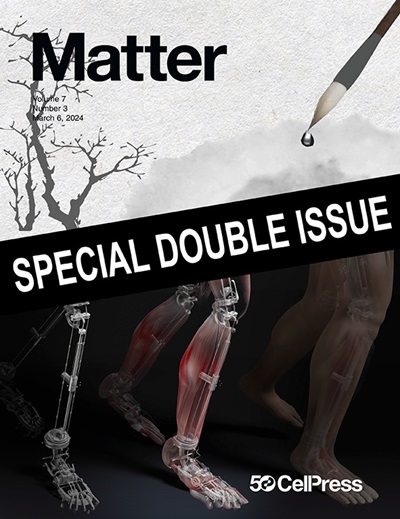用于光激活软机器人的二维碳化钛表面终端工程
IF 17.5
1区 材料科学
Q1 MATERIALS SCIENCE, MULTIDISCIPLINARY
引用次数: 0
摘要
过渡金属碳化物(TMC) Ti3C2Tx具有高导电性,光热转换和灵活性,使其成为光驱动软执行器的理想材料。然而,传统的合成通常会导致氟终止,从而降低光热效率。本研究引入了一种等离子体激活原子层刻蚀(plasma-ALE)方法来精确地设计Ti3C2Tx的表面末端,将表面化学从以氟为主的末端转变为以氧为主的末端,实现了80%的电导率提高和显著提高的光热效率。在近红外光下,纤维素纳米原纤维进一步改善了ale处理的致动器的响应,产生高达165°的弯曲和40 mN的力,优于其他基于2D材料的致动器。等离子体- ale工艺与各种制造方法兼容,包括真空过滤和气溶胶喷射打印,实现可扩展的设计。此外,等离子体ale处理促进了能够抓取和运动的驱动器。这项工作为tmc的高级表面工程及其与多功能软机器人系统的集成铺平了道路。本文章由计算机程序翻译,如有差异,请以英文原文为准。

Surface termination engineering of 2D titanium carbides for light-activated soft robotics applications
The transition metal carbide (TMC) Ti3C2Tx features high conductivity, photothermal conversion, and flexibility, making it promising for light-driven soft actuators. However, conventional synthesis often results in fluorine terminations that degrade photothermal efficiency. This study introduces a plasma-enabled atomic layer etching (plasma-ALE) approach to precisely engineer the surface termination of Ti3C2Tx, transforming the surface chemistry from fluorine-dominated to oxygen-dominated terminations, achieving an 80% conductivity increase and significantly enhanced photothermal efficiency. Incorporating cellulose nanofibrils further improves ALE-treated actuator response under near-infrared light, yielding up to 165° bending and 40 mN force, outperforming other 2D material-based actuators. The plasma-ALE process is compatible with various fabrication methods, including vacuum filtration and aerosol jet printing, enabling scalable designs. Furthermore, plasma-ALE treatment facilitates actuators capable of grasping and locomotion. This work paves the way for advanced surface engineering of TMCs and their integration into multifunctional soft robotic systems.
求助全文
通过发布文献求助,成功后即可免费获取论文全文。
去求助
来源期刊

Matter
MATERIALS SCIENCE, MULTIDISCIPLINARY-
CiteScore
26.30
自引率
2.60%
发文量
367
期刊介绍:
Matter, a monthly journal affiliated with Cell, spans the broad field of materials science from nano to macro levels,covering fundamentals to applications. Embracing groundbreaking technologies,it includes full-length research articles,reviews, perspectives,previews, opinions, personnel stories, and general editorial content.
Matter aims to be the primary resource for researchers in academia and industry, inspiring the next generation of materials scientists.
 求助内容:
求助内容: 应助结果提醒方式:
应助结果提醒方式:


